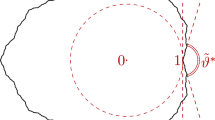Abstract
This work is devoted to the study of the scaling, and the consequent power-law behavior, of the correlation function in a mutation-replication model known as the expansion-modification system. The latter is a biology inspired random substitution model for the genome evolution, which is defined on a binary alphabet and depends on a parameter interpreted as a mutation probability. We prove that the time-evolution of this system is such that any initial measure converges towards a unique stationary one exhibiting decay of correlations not slower than a power-law. We then prove, for a significant range of mutation probabilities, that the decay of correlations indeed follows a power-law with scaling exponent smoothly depending on the mutation probability. Finally we put forward an argument which allows us to give a closed expression for the corresponding scaling exponent for all the values of the mutation probability. Such a scaling exponent turns out to be a piecewise smooth function of the parameter.


Similar content being viewed by others
Notes
According to our numerical computations.
References
Alvarez-Martínez, R., Martínez-Mekler, G., Cocho, G.: Order-disorder transition in conflicting dynamics leading to rank-frequency generalized beta distributions. Physica A 390(1), 120–130 (2011)
Buldyrev, A.L., Goldberger, A.L., Havlin, S., Mantegna, R.N., Matsa, M.E., Peng, C.-K., Simons, M., Stanley, H.E.: Long-range correlation properties of coding and noncoding DNA sequences: GenBank analysis. Phys. Rev. E 51, 5084–5091 (1995)
Godrèche, C., Luck, J.M.: Quasiperiodicity and randomness in tilings of the plane. J. Stat. Phys. 55(1/2), 1–28 (1989)
Koslicki, D.: Substitution Markov chains with applications to molecular evolution. Ph.D. Dissertation, Pennsylvania State University (2012)
Li, W.: Spatial l/f spectra in open dynamical systems. Europhys. Lett. 10(5), 395–400 (1989)
Li, W.: Expansion-modification systems: a model for spatial 1/f spectra. Phys. Rev. A 43(10), 5240–5260 (1991)
Li, W., Kaneko, K.: Long-range correlation and partial 1/f a spectrum in a noncoding DNA sequence. Europhys. Lett. 17, 655–660 (1992)
Li, W.: The study of correlation structures of DNA sequences: a critical review. Comput. Chem. 21, 257–271 (1997)
Ma, J., Ratan, A., Raney, B.J., Suh, B.B., Miller, M., Haussler, D.: The infinite site model of genome evolution. Proc. Natl. Acad. Sci. 105, 14254–14261 (2008)
Mansilla, R., Cocho, G.: Multiscaling in expansion-modification systems: an explanation for long range correlation in DNA. Complex Syst. 12, 207–240 (2000)
Martínez-Mekler, G., Alvarez-Martínez, R., Beltrán del Río, M., Mansilla, R., Miramontes, P., Cocho, G.: Universality of rank-ordering distributions in the arts and sciences. PLoS ONE 4, e4791 (2008), 7 pp.
Messer, P.W., Arndt, P.F., Lässig, M.: Solvable sequence evolution models and genomic correlations. Phys. Rev. Lett. 94, 138103 (2005)
Peng, C.-K., Buldyrev, S.V., Goldberger, A.L., Havlin, S., Sciortino, F., Simons, M., Stanley, H.E.: Long-range correlations in nucleotide sequences. Nature 356, 168–179 (1992)
Robbins, H.: A remark on Stirling’s formula. Am. Math. Mon. 62(1), 26–29 (1955)
Rocha, A.V., Simas, A.B., Toom, A.: Substitution operators. J. Stat. Phys. 143, 585–618 (2011)
Saakian, D.B.: Evolution models with base substitutions, insertions, deletions, and selection. Phys. Rev. E 78, 061920 (2008)
Sobottka, M., Hart, A.G.: A model capturing novel strand symmetries in bacterial DNA. Biochem. Biophys. Res. Commun. 410, 823–828 (2011)
Zaks, M.: Multifractal Fourier spectra and power-law decay of correlations in random substitution sequences. Phys. Rev. E 65, 011111 (2001)
Author information
Authors and Affiliations
Corresponding author
Rights and permissions
About this article
Cite this article
Salgado-García, R., Ugalde, E. Exact Scaling in the Expansion-Modification System. J Stat Phys 153, 842–863 (2013). https://doi.org/10.1007/s10955-013-0866-x
Received:
Accepted:
Published:
Issue Date:
DOI: https://doi.org/10.1007/s10955-013-0866-x




